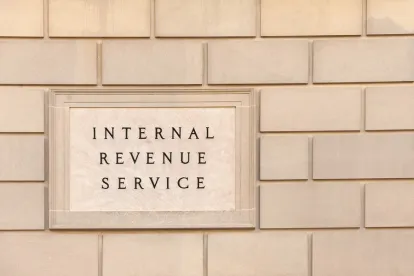Summary
The IRS recently released Notice 2018-95 to provide transition relief to 403(b) plan sponsors that improperly excluded part-time employees from making elective deferrals under their plans. Employers must begin to operate the part-time employee exclusion under their 403(b) plans correctly for the plan year immediately following the transition relief period, which will mean as soon as January 1, 2019 for many 403(b) plan sponsors. In addition, going forward, many employers will need to amend their 403(b) plans to properly reflect the conditions that must be satisfied to exclude part-time employees from 403(b) plan participation.
In Depth
On December 4, 2018, the Internal Revenue Service (IRS) released Notice 2018-95 (Notice) to provide transition relief to 403(b) plan sponsors that erroneously excluded part-time employees from making elective deferrals under their 403(b) plans, even though those employees should have been eligible to contribute under the “once-in-always-in” (OIAI) requirement.
Background
Under the “universal availability” requirement that applies to 403(b) plans, all employees of an employer maintaining the 403(b) plan generally must be permitted to make elective deferrals if any employee of the employer is permitted to make elective deferrals. Practically, this means that all employees of an employer generally must be eligible to participate in an employer’s 403(b) plan. However, there are exceptions to the universal availability requirement that allow an employer to exclude certain categories of employees from plan participation.
One exception to the universal availability requirement relates to the exclusion of part-time employees who normally work fewer than 20 hours per week. To exclude a part-time employee, an employer must satisfy three separate conditions:
-
First-Year Exclusion Condition. The employer must reasonably expect the employee to work fewer than 1,000 hours during the employee’s first year of employment.
-
Preceding-Year Exclusion Condition. The employee must actually work fewer than 1,000 hours during the preceding 12-month period.
-
Once-In-Always-In (OIAI) Exclusion Condition. The employee must actually work fewer than 1,000 hours during all subsequent years.
If an employee is expected to work at least 1,000 hours during his or her first year of employment (and, therefore will not satisfy the first-year exclusion condition) or works at least 1,000 hours during any subsequent year (and, therefore will not satisfy either the preceding-year exclusion condition or the OIAI exclusion condition), the employer must allow the employee to make deferrals under its 403(b) plan. Once the employee becomes eligible to participate, he or she cannot later be excluded, even if the employee works fewer than 1,000 hours for the employer a future year. In other words, once the employee is in the employer’s 403(b) plan, he or she is always in.
Historically, however, many employers have not properly applied the OIAI requirement. Instead, employers evaluated whether a part-time employee should be eligible to make deferrals under a 403(b) plan by applying the preceding-year exclusion condition separately for each subsequent year, but did not apply the OIAI exclusion condition. As a result, some part-time employees who entered an employer’s 403(b) plan after working more than 1,000 hours during one year were excluded in a subsequent year when their service dropped back below 1,000 hours. This means that part-time employees who should have been eligible to participate in the employer’s 403(b) plan were excluded.
Transition Relief for 403(b) Plans
The Notice provides transition relief for employers that failed to properly apply the OIAI exclusion condition and, as a result, erroneously excluded part-time employees from their 403(b) plans. This relief includes relief regarding plan operation for a transition relief period, relief regarding plan language, and a “fresh start” opportunity after the relief period ends. To qualify for the relief, 403(b) plan sponsors must satisfy certain requirements.
Transition Relief Period under the Notice
The transition relief period under the Notice begins with taxable years after December 31, 2008, and ends (1) for 403(b) plans which determine eligibility/exclusion based on a plan year, the last day of the plan year that ends before December 31, 2019 (which, for calendar year plans, means by December 31, 2018); and (2) for 403(b) plans which determine eligibility/exclusion based on the employee’s anniversary date, the last day of that employee’s last anniversary year that ends before December 31, 2019.
Conditions for Receiving Transition Relief under the Notice
An employer will qualify for transition relief as long as the employer consistently (even if incorrectly) administered the part-time employee exclusion (i.e., by using the first-year and preceding-year exclusion conditions, but not the OIAI exclusion condition) and begins to operate the part-time employee exclusion correctly under its 403(b) plan immediately following the transition relief period.
Transition Relief Provided Under the Notice
More specifically, for employers that qualify for transition relief, the Notice provides that:
-
Relief regarding plan operation. During the transition relief period, a 403(b) plan will not be treated as failing to satisfy the conditions of the part-time employee exclusion simply because the plan was not operated in compliance with the OIAI exclusion condition. Importantly, this relief does not apply to a failure to properly comply with the other part-time employee exclusion conditions, including the first-year and preceding year exclusion conditions or the consistency requirement.
-
Relief regarding plan document language. Relief for defects in plan language is also available, but differs based on whether an employer sponsors a pre-approved or individually designed 403(b) plan:
‒ A pre-approved 403(b) plan adopted by an employer will not be treated as failing to satisfy the conditions of the part-time employee exclusion simply because the form of the pre-approved plan for the transition relief period does not match the plan’s operation with regard to the OIAI exclusion condition during the transition relief period. This means the pre-approved 403(b) plan is not required to be amended to reflect that the plan failed to properly apply the OIAI exclusion condition during the transition relief period.
‒ An individually designed 403(b) plan adopted by an employer must be amended by March 31, 2020, to reflect the actual administration of the OIAI exclusion condition during the transition relief period. The amendment will be treated as a correction of the plan documentary failure during this period.
In addition, pre-approved and individually designed 403(b) plans that include the part-time employee exclusion must be amended to specifically reflect the proper OIAI exclusion condition for periods after the transition relief period ends. This amendment is required by March 31, 2020.
-
Relief related to fresh-start opportunity. A plan will not be treated as failing to satisfy the conditions of the part-time employee exclusion for periods after the transition relief period if the OIAI exclusion condition is applied as if it first became effective January 1, 2018.
Next Steps
Employers that sponsor 403(b) plans should determine whether the OIAI exclusion condition has been correctly applied in prior years. If the OIAI exclusion condition has not be properly applied the employer must begin to operate the part-time employee exclusion under its 403(b) plan correctly for the plan year immediately following the transition relief period (which may mean as soon as January 1, 2019). In addition, employers will be required to amend their plans to properly reflect the OIAI exclusion condition under the part-time employee exclusion.




 />i
/>i


